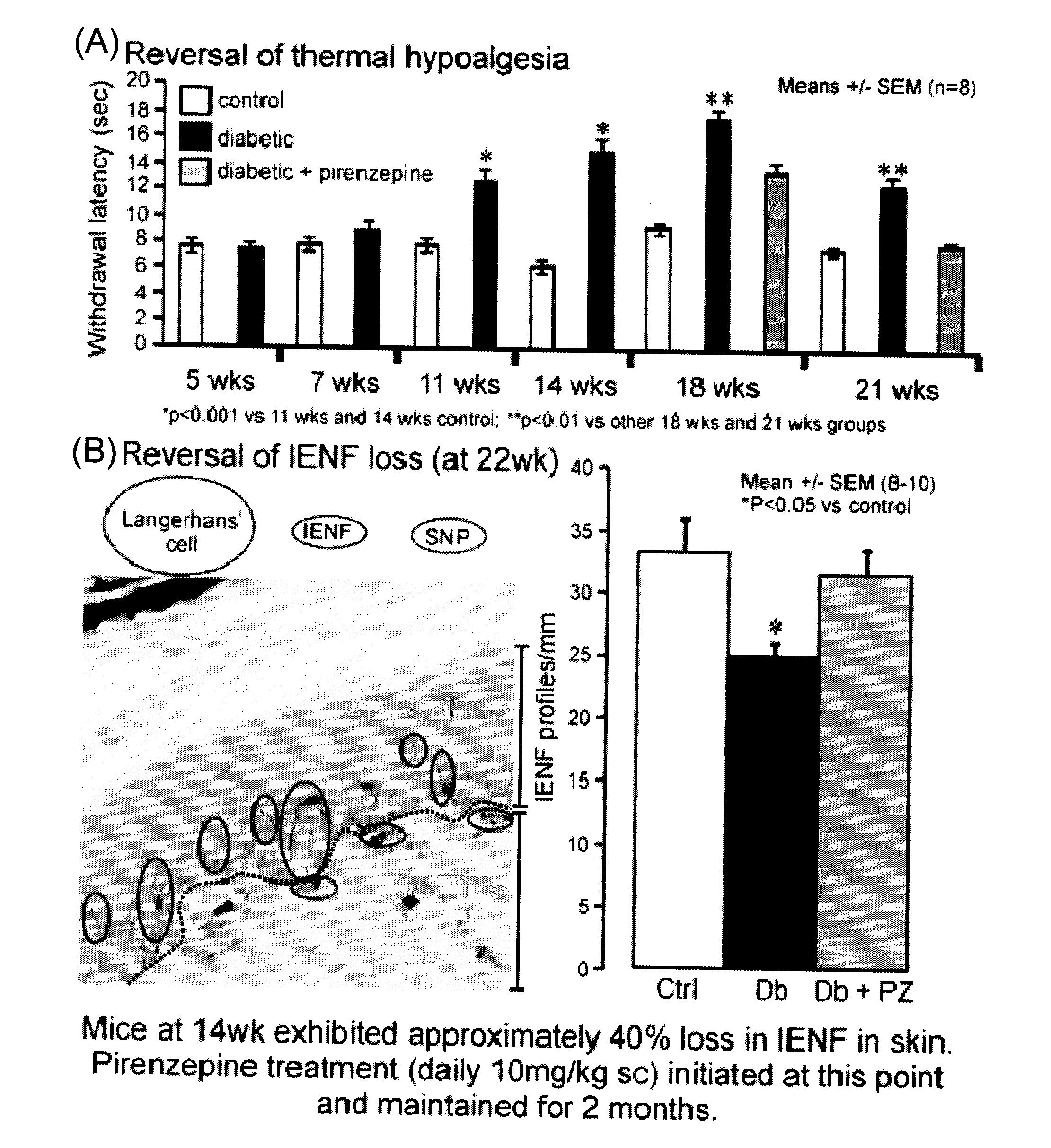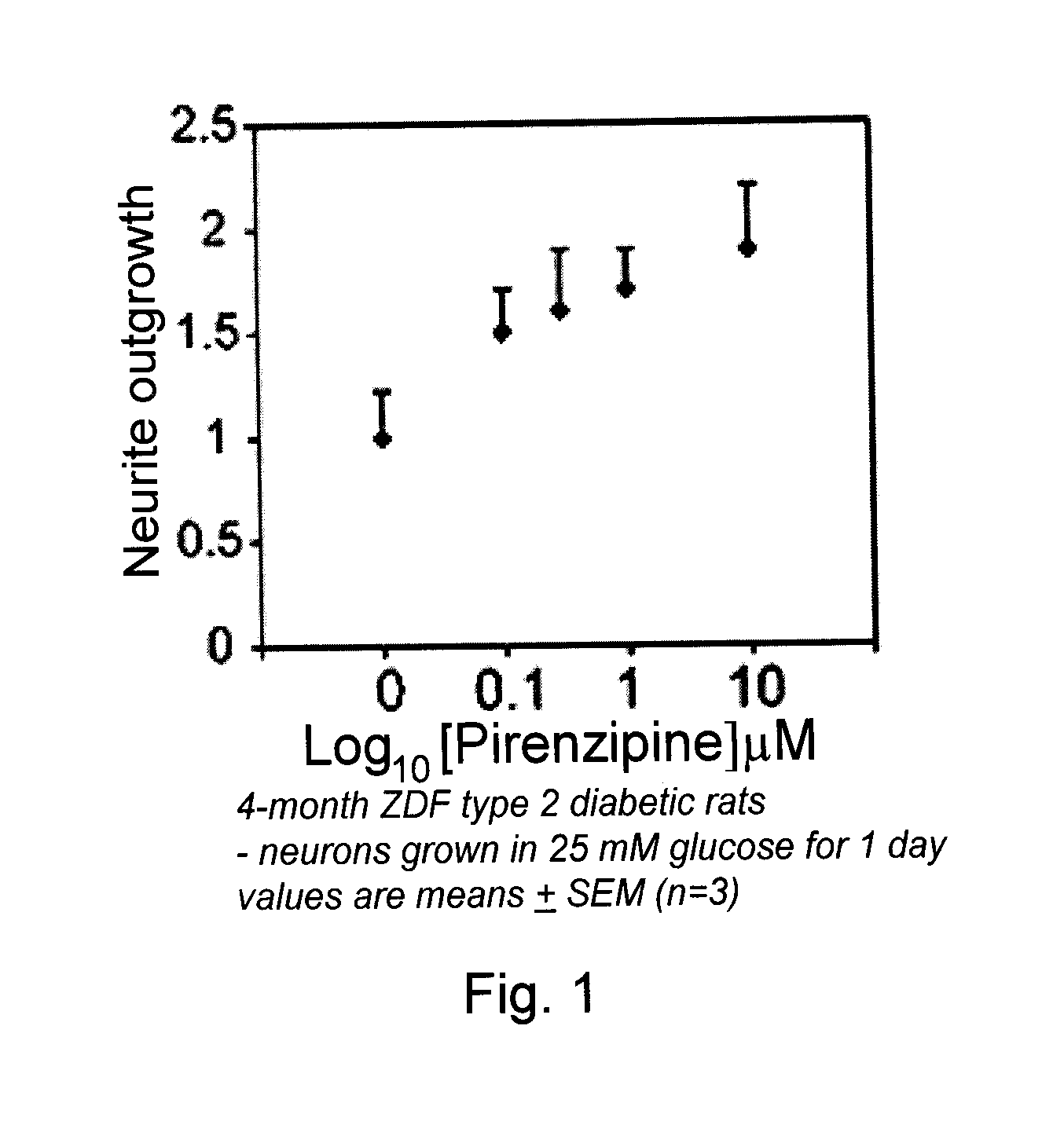Therapeutic compositions for diabetic symmetrical polyneuropathy
- Summary
- Abstract
- Description
- Claims
- Application Information
AI Technical Summary
Benefits of technology
Problems solved by technology
Method used
Image
Examples
example 1
Effects of Pirenzepine on Outgrowth of Neurites from Excised Neurons in a Type 2 Diabetes Rat Model
[0100]Sensory neurons from cervical, thoracic and lumbar DRG of a 3-4 month old adult male ZDF diabetic rat (model of type 2 diabetes) were isolated and dissociated using a method based on the teachings of Fernyhough et al. (1993, Brain Res. 607:117-124), Gardiner et al. (2005, Mol. Cell. Neurosci. 28:229-240), and Huang et al. (2003, Diabetes 52:2129-2136). Briefly, DRG were removed from all spinal levels, their roots trimmed, and then the cells were chemically dissociated in 0.125% collagenase (Worthington Biochemical Corp., Lakewood, N.J., USA) in F12 nutrient medium (Invitrogen Canada Inc., Burlington, ON, Canada) for 1.5 h at 37° C. The ganglia were then mechanically dissociated by treatment with 0.05% trypsin (Worthington Biochemical Corp.) in F12 nutrient medium, followed by trituration with a glass pipette. The resulting cell suspension was then centrifuged at 600 rpm for 5 min...
example 2
Effects of Selected Muscarinic Acetylcholine Receptor Antagonists on the Outgrowth of Neurites from Excised Neurons from a Normal Rat
[0101]Sensory neurons from cervical, thoracic and lumbar DRG of a 3-4 month old non-diabetic adult male Sprague Dawley rat were isolated and dissociated using the method described in Example 1. The excised and dissociated neuron cells were plated onto poly-L-ornithine-laminin-coated NUNC 48-well or 96-well plastic dishes with optically clear glass bottoms in serum-free and insulin-free F 12 medium in the presence of modified N2 additives (containing no insulin) at 37° C. in a 95% air / 5% CO2 humidified incubator. All cultures were exposed to the following additional conditions: 10 mM D-glucose, 0.1 nM insulin, 0.3 ng / ml NGF, 1 ng / ml NT-3 and 5 ng / ml GDNF (all obtained from Sigma-Aldrich Canada Ltd.). Upon plating, the neurons were exposed to these conditions and immediately treated with one of the following three muscarinic acetylcholine receptor antago...
example 3
Effects of Low Concentrations of Two Selective M1R Antagonists on the Outgrowth of Neurites from Excised Neurons in a Normal Rat
[0102]Sensory neurons from cervical, thoracic and lumbar DRG of an adult 3-4 month old male Sprague Dawley rat were isolated and dissociated using the method described in Example 1, and then were cultured for 24 h in serum-free and insulin-free F12 medium in the presence of modified N2 additives. Upon plating, the neurons were immediately treated with either: (A) pirenzepine-HCl dosages ranging from 0 to 0.1 μM (solid diamonds), or (B) a novel antimuscarinic agent code-named “VU255035” (solid squares). VU0255035 [N-(3-oxo-3-(4-(pyridine-4-yl)piperazin-1-yl)propyl)-benzo[c][1,2,5]thiadiazole-4 sulfonamide] is a novel M1R specific antagonist (Sheffler et al., 2009, Molecular Pharmacology 76: 356-368). Equilibrium radioligand binding and functional studies demonstrate a greater than 75-fold selectivity of VU0255035 for M1R relative to M(2)-M(5). Molecular phar...
PUM
| Property | Measurement | Unit |
|---|---|---|
| Composition | aaaaa | aaaaa |
| Viscosity | aaaaa | aaaaa |
| Therapeutic | aaaaa | aaaaa |
Abstract
Description
Claims
Application Information
 Login to View More
Login to View More - R&D
- Intellectual Property
- Life Sciences
- Materials
- Tech Scout
- Unparalleled Data Quality
- Higher Quality Content
- 60% Fewer Hallucinations
Browse by: Latest US Patents, China's latest patents, Technical Efficacy Thesaurus, Application Domain, Technology Topic, Popular Technical Reports.
© 2025 PatSnap. All rights reserved.Legal|Privacy policy|Modern Slavery Act Transparency Statement|Sitemap|About US| Contact US: help@patsnap.com



